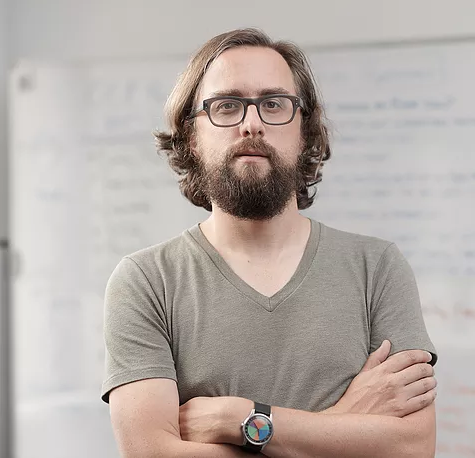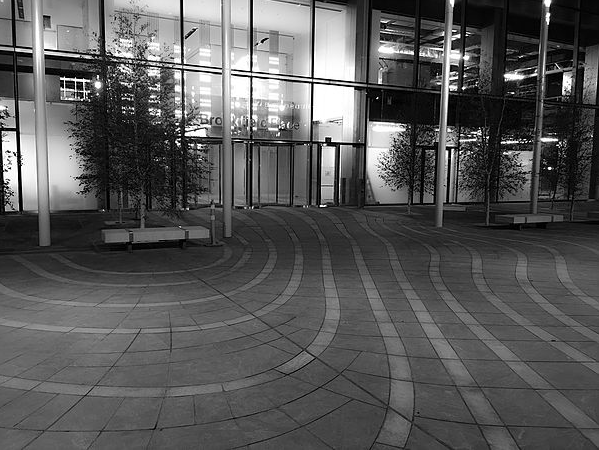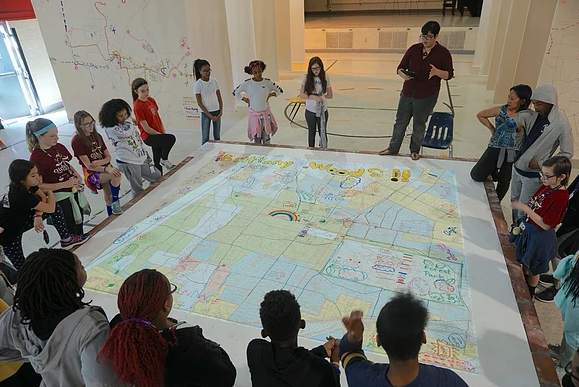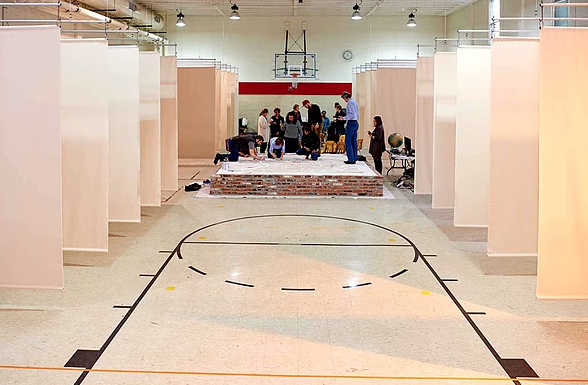Jer Thorp creates data-based public art to engage and empower communities
Jer Thorp is an accomplished public speaker—check out some of his selected talks here—and an artist based in New York who has participated in highly visible public art projects, like designing the algorithm for the placement of the nearly 3,000 names on the 9/11 Memorial. But he describes himself as a “data artist,” which begs the question…what exactly is a “data artist?”
“It’s a term that I more or less made to have people ask that,” he laughs. “I see myself as an artist whose work thinks about data, rather than necessarily an artist whose work uses data. My practice focuses on what people’s relationship to data is and how it changes.”

Through the work he produces, Thorp is trying to find ways to give people agency and clarity to understand otherwise confusing data systems, and to be critical of the things happening at a rapid pace all around us.
He says he doesn’t really have a background in art—he studied biology and genetics in college but never finished his degree, then did web design as a way to pay the bills at the beginning of the 2000s.
“With that work I figured out ways to be creative through programming and computation,” he says. “At the same time, I grew really skeptical about what the tech industry was doing and how people were being treated, so those two threads ran together. I built myself a practice writing software and started to understand that we were having a really big problem with how corporations were using people’s data and how people are excluded from that process.”
He admits that it’s a little “eerie” that these things he’s been talking about for nearly two decades are now finally central policy discussions, but, he adds, “The reason we’re here now is because people wouldn’t listen then.”
Thorp started working with code-based art in 1999. Ten years later he was focusing only on data. In the last six or seven years, he says, his practice took on much more of an activist bend: “My work has become more focused on empowerment and trying to bring data into public spaces.”
Now there is a huge push towards open data, and more and more governments, institutions, and businesses are making their data available to the public. Despite that level of access to open data, however, Thorp feels there’s a greater urgency around empowering individuals and communities to do that data analysis work themselves and find their voice in these conversations that deal with data…their data, and the data on the city that they live in, rather than having some outside third party company come in telling them what the data says about them.

Thorp creates a lot of public art, and says that work he has co-created over the last few years has brought a confluence of a lot of things he had been thinking about, including what it means to bring data into a public space and also how to use environmental data to engage the public.
One of the projects he worked on last year was called Herald/Harbinger in downtown Calgary. He and his collaborators installed a permanent sensor system on the Bow Glacier nearby in Canada’s Banff National Park that converts the glacier’s data into sound and light 24/7, visualizing the data from the glacier in such a way that people directly experience it with their senses rather than as a mathematical abstraction. (Read more about this project from Thorp here.)
“What does it mean to give an inanimate object, a glacier, a voice in the city?” he asks. “This project is located in a huge plaza in downtown Calgary and is really meant to be consumed over time—months and years—by the people who commute through that place every day. There is always that continual pinging of the data in the background. For individuals, that’s not really how you expect to interact with data.”
Another project, St. Louis Map Room, was a culmination of several years of thinking through ideas on community data use and empowerment.
Thorp was approached by the St. Louis community arts organization Center of Creative Arts in 2014. They were interested in working on small a project together using their organization’s data, but Thorp immediately started dreaming of something bigger—a big public sculpture or some type of large-scale participatory project.
Then Michael Brown was fatally shot in Ferguson, just a few miles from St. Louis, and the project changed completely.
“It was very obvious to me immediately that this was no place for me to do a kind of grand artwork that felt like I was the author of it,” says Thorp. “Instead I realized quite quickly that we needed to build a space for the community that felt much more like a platform.”

They found an empty space to suit their needs—a school on the city’s Northside that they were able to use for two months. During that time, facilitator Emily Catedral worked with local school, community, and activist groups to bring community members into this space to author 10’x10’ maps to “map” their experience of the city—students mapped their routes to school and where it was or wasn’t safe; community groups mapped out community gardens, churches, magnet schools, and food banks.
As explained on the project’s webpage, “If mapping is a source of power, each mapper claimed some of it by making maps of their community that reflected them as they are, or that communicated what they’d like them to be.”
Once a map was drawn, organizers projected civic data collected from St. Louis onto it, including bus lines, poverty levels, and historical red-lining maps. Also from the project’s page: “Normally these data are difficult, if not impossible, to access without deep technical knowhow. The mappers were surprised to see their experiences confirmed—or challenged—by data that were invisible to them before.”
Thorp hoped that by doing this “mapping” work, it would help community members to have a better understanding of what city data could offer them and perhaps enable them to understand their experience in the community differently. But he also wanted it to act as a critical lens for people to be able to say, “This civic data does not represent me and I can point to places on this map where my story is not being told.”
They’ve done more Map Room projects on a smaller scale in Atlanta and Philadelphia, and Thorp says the next phase he is working on is turning Map Room into a foundation that would allow anyone anywhere to do a Map Room project of their own to help them re-vision what the future of their community can be—not through the voice of city planners but through the voices of the kids and activists and senior citizens and everyone else who lives there speaking what they imagine for their future. This framework can be used on any kind of geography: a city street, a rural environment, a migrant camp, or anywhere else that people live.

The Map Room Project is actively looking for people interested in doing Map Rooms where they live, and Thorp hopes that in the next few years it will become something that will help people build data literacy in their communities and also empower them to have a louder voice in their communities.
Currently Thorp is writing a book called Living in Data, scheduled to come out next spring. He says it’s about how our relationship to data was defined for us over the last 30 years, how it’s changing, and how we might define new futures for the way the data could be used and how it could help us.
“In some ways it’s a memoir of my work, but it’s also an investigation into other people and groups doing things in different ways that are really counter to the messages we get from Silicon Valley and the government and the military industrial complex about what data is and what it can do for us.”

(1) How do you like to collaborate?
Always! Everything I do is collaboration and I’ve learned a lot about the right ways to collaborate. I just finished long solo residency at the Library of Congress that I kept trying to find ways to make collaborative and came up with some great rules that are really useful for any collaboration: listen, share, and make space. In working on any collaborative project, those are three things I like to think about all the time. Am I listening? Am I also sharing? Am I trying to release these things in me? And as a white many who holds a lot of privilege, can I make space for others for whom maybe these collaborations aren’t as easy to come by?
(2) How do you a start a project?
Sometimes someone comes to me with an idea that’s just too good and it feels like an interesting, collaborative opportunity I don’t want to lose. But mostly they start slowly. Sometimes ideas just bubble up over years and years and when a potential project comes up I’ll lift up that idea, hold it up to the light and see if it matches and if not, that’s okay—that idea’s time will come up. Patience is key. Some ideas I had a decade ago and am only now finding ways to do something with them.
(3) How do you talk about your value?
I have a long background as a teacher—I started teaching in my first year of university in 1993, and I think that much of the value I have and that my work has come from my experience as a teacher. I’m always interested in how I can increase someone else’s knowledge and excitement about something. That doesn’t mean I think of my work as particularly pedagogical; what I want from something is for people to learn, and that learning could be a shift in the way they feel about something or a shift in the way they feel they have a voice or empowerment. My value I hope comes in being a kind of amplifier for others—to see the work, use the tools I’ve made, read the words I’ve written, then push their own change and make their own things.
(4) How do you define success?
I’m terrible at that. I’m only now coming to grips with how to finish a project and feel like I’ve done a good job. Especially with long-term projects, there are so many places that could have gone one way or another, for me at least. There is no such thing as the “right” path to go down; there’s just the path you went down. Now I’m trying to think less about how much attention a project got—how often it was talked about on Twitter, that sort of thing—but more, “Were the pathways I took interesting to me and were those the most interesting to take? Is the work that I’m doing amplifying in small or large ways? Do I feel like the work is encouraging people to go down strange paths?”
When I get an email from somebody saying, “I saw you give a talk six years ago and now I’m doing this thing, what do you think?” that’s awesome to me.
(5) How do you fund your work?
The company I ran for seven years was kind of an experiment to see if we could do work that was not supporting capital and do it outside of academic institutions and corporate research departments. We tried to do that, supporting more art-focused work with paid research and development consulting work. We found it was a better Idea to weigh those things equally, so we said let’s try to get them equally funded and have them influence each other. That worked also but it was beholden to granting cycles.
In full transparency, for a good part of the last decade I’ve had a well-paid speaking career and that’s how I’ve funded my work. Map Room cost well into six figures, out of which $20,000 was funded by someone who wasn’t me. I put a lot of my own money into that.
Most of the time I’m making it work by combining my own resources with resources from others. That works out well for me. A lot of artists who do same thing that I do, their side gig is advertising work and I don’t have the stomach for that anymore. This allows me to do work I believe in. The public speaking works really well. I’m often speaking to people from a corporate audience but I’m speaking about data and ethics and I use the work I’ve done to get them to think about those things differently.
I think all of us have to weigh what we’re willing to do. For me, I try to keep that line fairly clear. Even with public speaking, there are a lot of things that I say, “I’m not going to do that.” My measure is to ask, is the net positive going to be at the right level for me to talk to these people? Are my ideas going to be amplified?
